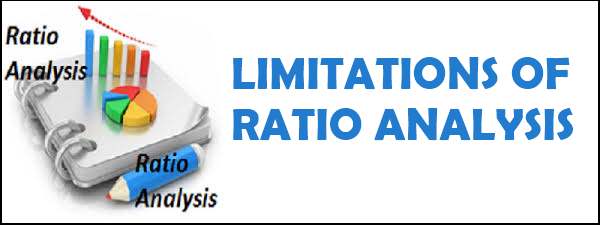Limitations of Ratio Analysis
Ratio analysis is treated as knife. If a knife is used by a doctor, he/she can save the life of human beings during the operation. At the same time, a knife is used by a kitchen master, he/she can cut the fruits and vegetables for early completion of the food preparation.
Likewise, a knife is used by culprit, he/she can put an end to life of human being. Hence, it is noticed that, undoubtedly, ratio analysis is a tool available in the hands of analyst and the significance of ratio analysis is based on its usage.
According to Hunt, Williams and Donaldson,
“The ratio analysis is an aid to management in taking credit decisions but as a mechanical substitute for thinking and judgement, it is worse than useless”.
Ratio analysis suffer from certain limitations even though they are easily calculated and understood. Such limitations are given below..

Table of Contents
- 1 Limitations of ratio analysis
- 1.1 1. Limited use of Single Ratio
- 1.2 2. No Inter Firm Comparison
- 1.3 3. Lack of Adequate Standards
- 1.4 4. Complicated and Misleading Conclusion
- 1.5 5. Inherent Limitations of Accounting
- 1.6 6. Time lag in Calculation and Communication
- 1.7 7. A Change in the Accounting Procedure
- 1.8 8. No Complete Technique of Analysis and Interpretation
- 1.9 9. Window Dressing
- 1.10 10. Personal Bias
- 1.11 11. Ratios on Substitutes
- 1.12 12. Not an end but only a means
Limitations of ratio analysis
1. Limited use of Single Ratio
A single ratio cannot convey any meaning at all. Hence, some more ratios are calculated to know something from a single ratio. Sometimes, the calculation of many ratios lead to confusion instead of helping the analyst to make meaningful conclusion.
2. No Inter Firm Comparison
If the business concerns are not similar in size and nature, there is no possibility of inter firm comparison through ratio analysis.
3. Lack of Adequate Standards
There is no standard for any ratio. Only rules of thumb for all the ratios are accepted and followed. Hence, the interpretation of ratio is difficult.
4. Complicated and Misleading Conclusion
Ratios may make the comparative study more complicated and misleading conclusion on account of changes in price level.
5. Inherent Limitations of Accounting
Historical nature of information are used for calculating ratios. The reason is that the financial statements are prepared on historical information. It is an inherent limitation of accounting. Hence, the ratios are not necessarily be true indicators of the future.
6. Time lag in Calculation and Communication
The financial statements are prepared only after the completion of accounting year and then approved by a qualified auditor. These financial statements are published after annual general body meeting is over. It requires six months to nine months. If so, there is no use of calculation and communication of ratios.
7. A Change in the Accounting Procedure
A change in the accounting procedure refers to change in the valuation of inventories. If the business concern follows FIFO method for calculating the valuation of inventory first and then charged to LIFO method. In such a case, the value of closing stock is reduced and increase the cost of sales. If so, gross profit and net profit are reduced to some extent. Under this situation, the stock turnover ratio, gross profit ratio and net profit ratio are some what differ.
8. No Complete Technique of Analysis and Interpretation
Ratio analysis is not only one technique of analysis and interpretation. It is used along with other tools and techniques to draw any conclusion.
9. Window Dressing
The window dressing of financial statements is very easy. If so, the weak financial position of the business concern may be shown as strong financial position. In such a situation, an analyst may take wrong conclusion and decision based on the calculated ratios. Hence, it is very difficult to an outsider to know about the window dressing made by the business concern.
10. Personal Bias
Different interested parties are using the same ratios in a different way. It leads to personal bias. Nobody compel anybody in the analysis and interpretation of ratios.
11. Ratios on Substitutes
Ratio analysis is just a tool of financial statements. Therefore, they are meaningless if they are segregated from from the financial statements from which they are computed.
12. Not an end but only a means
Ratios are not an end in the themselves but they are means to achieve particular objective.

